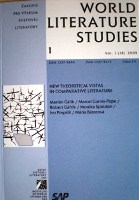Modern and Non-Modern Conservativism: Comparative Approaches and Identifying Modernism
Modern and Non-Modern Conservativism: Comparative Approaches and Identifying Modernism
Author(s): Mária BátorováSubject(s): Literary Texts
Published by: Ústav svetovej literatúry, Slovenská akadémia vied
Keywords: Literárna moderna; Komparatistika; Pozitívne a negatívne konzervatívne hodnoty
Summary/Abstract: In this paper I have in mind what art, especially literature, means for the modern person — whether and how literature can influence the direction and development of a human life, and thus in turn of humankind. Whether literature is something written by an author and then interpreted by the theorist; or whether the author is simultaneously writer and interpreter in one. The approach I take — one of permanent comparing and of looking to the context of individual items — is based on Ďurišin’s theory of typological and genetic comparison. I have dealt with the theory elsewhere and I have also developed aspects of it in relation to interdisciplinary analysis and studies of discourse. For a more comprehensive discussion, see the introductory chapter, ‘Kontextualisierung des literarischen Werkes’, of my monograph.2 My speculations follow the direction of A. Compagnon whose work draws on the research of the past two decades to do with the meaning of art and the notion of mimesis as recognition. Compagnon weaves threads from the works of Frey, Ricoeur and Ginzburg, whose convoluted theoretical questions are elaborated in the third chapter, ‘Svet’ (The World) of his book, Démon teórie (Literature, Theory, and Common Sense). In the earlier chapters Compagnon has tried to come to a definition of literature, focusing mainly on the subject of the author and his or her intention. Compagnon examines theories that have questioned or displaced the idea of authorial intention and that, putting aside the cultural, historical and social context of a work of literature, gave pre-eminence to the narrative value of the text itself. Compagnon distances himself from these theories, writing: ‘I would like to step out of the trap of this absurd alternative between objectivism/subjectivism and demonstrate that the only possible criterion for the validity of the interpretation is definitely the intention, which, however, cannot be identified with ‘the clear and prescient purpose’ (ibid., p. 84). Compagnon attempts to escape the objectivist/subjectivist dichotomy with an appeal to a more complex understanding of what art is and of the function of literature in society in his discussion of the most prominent theorists of the second half of the 20th century.
Journal: World Literature Studies
- Issue Year: I/2009
- Issue No: 1
- Page Range: 62-70
- Page Count: 8
- Language: English

